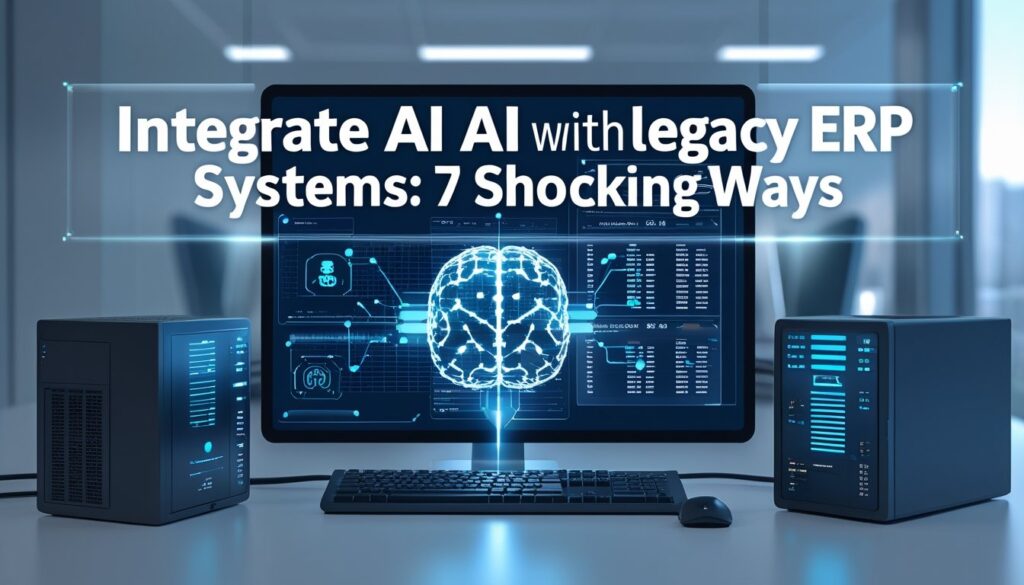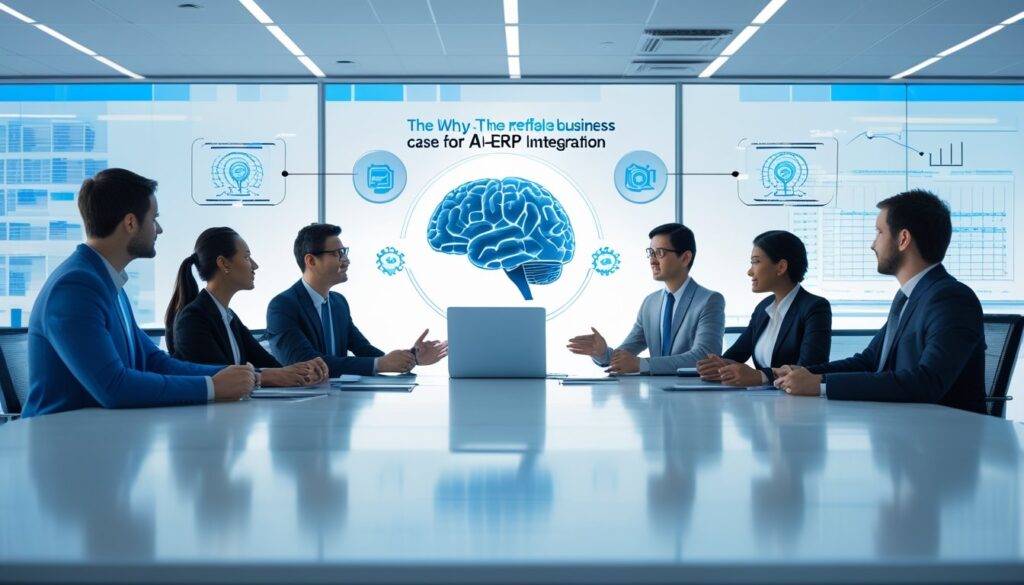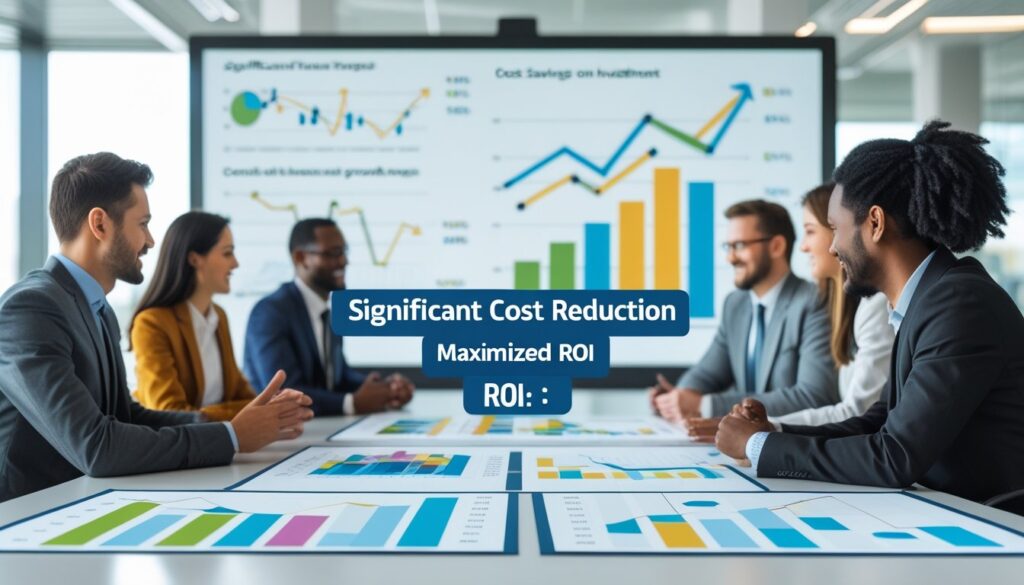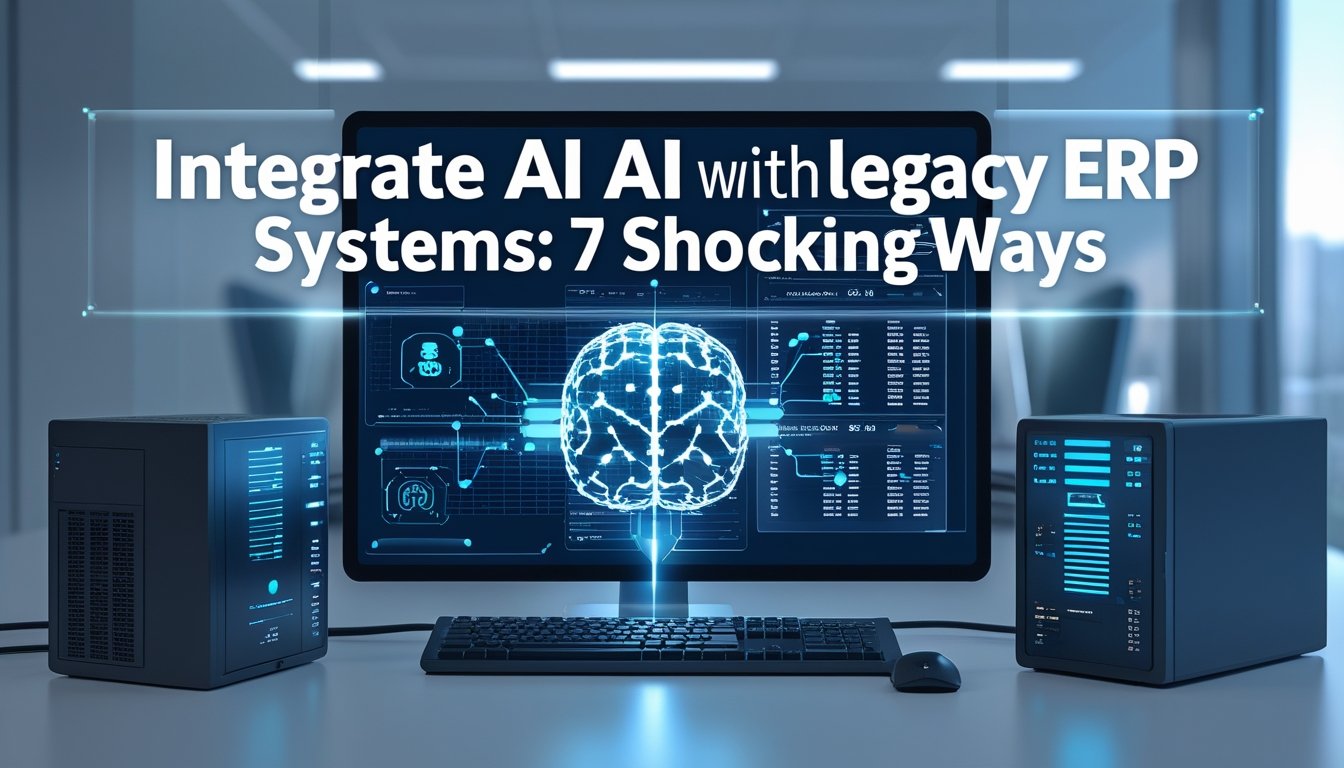Unlock the hidden value in your legacy ERP. This 7000-word definitive guide explores the strategies, benefits, and step-by-step process for successfully integrating AI to boost efficiency, gain insights, and drive innovation.

The Sleeping Giant in Your Server Room
For decades, your Enterprise Resource Planning (ERP) system has been the central nervous system of your organization. It manages everything from finance and inventory to human resources and supply chain. These legacy systems, often built on platforms like SAP R/3, Oracle E-Business Suite, or custom-built solutions, are stable, deeply embedded in your processes, and represent a significant historical investment. They are also, quite often, seen as relics—inflexible, data-rich but insight-poor, and resistant to the agility demanded by the modern digital economy.Legacy ERP
Meanwhile, Artificial Intelligence (AI) and Machine Learning (ML) represent the vanguard of innovation, promising unprecedented efficiency, predictive power, and automation. The common, and costly, misconception is that to harness this power, you must embark on a multi-year, multi-million-dollar “rip-and-replace” ERP modernization project.Legacy ERP
This guide dismantles that myth.
We will demonstrate that your legacy ERP is not a boat anchor holding you back, but a sleeping giant—a vast repository of untapped operational intelligence. By integrating AI with your existing systems, you can awaken this giant, unlocking transformative value without the extreme risk and cost of a full-scale replacement. This is not about a future possibility; it is a present-day strategic imperative.Legacy ERP
This comprehensive guide will walk you through the why, the how, the what, and the what-if of integrating AI with legacy ERP. We will cover:
- The Compelling Business Case: The tangible ROI and strategic advantages.
- Understanding the Legacy Landscape: The unique challenges and opportunities of older systems.
- A Strategic Framework for Integration: A phased, proven approach from assessment to scaling.
- In-Depth Use Cases by Business Function: Concrete examples for Finance, Supply Chain, HR, and more.
- Technology Architecture: API-led, middleware, and microservices patterns.
- Vendor Selection & The Build vs. Buy Decision.
- Managing Change and Building an AI-Ready Culture.
- Measuring Success and Scaling Your Initiatives.
The “Why” – The Irrefutable Business Case for AI-ERP Integration

Before delving into the technical “how,” it’s crucial to establish a rock-solid business case. This alignment with core business objectives is what separates successful, ROI-positive projects from expensive science experiments.Legacy ERP
From Descriptive to Prescriptive and Predictive Analytics
Legacy ERPs are exceptional at descriptive analytics—telling you what happened. They generate reports on last quarter’s sales, last month’s inventory levels, and yesterday’s production output. AI shifts the paradigm:
- Predictive Analytics: Using historical ERP data, AI models can forecast future outcomes. What will demand be for this product next season? Which customers are most likely to churn? Which machines are likely to fail in the next 90 days?
- Prescriptive Analytics: This is the holy grail. AI doesn’t just predict an outcome; it recommends specific actions to achieve a desired outcome or avoid a negative one. To meet the predicted demand, increase purchase orders for these raw materials by 15% and schedule overtime in the third week of July. To prevent that machine failure, schedule maintenance for next Tuesday and order the required part now.
Hyper-Automation Beyond RPA
Robotic Process Automation (RPA) has been a popular tool for automating repetitive, rule-based tasks like data entry. However, RPA is brittle—it breaks when processes change. AI introduces cognitive automation:
- Intelligent Document Processing (IDP): Automatically read, interpret, and process semi-structured documents like invoices, bills of lading, and purchase orders, even if they arrive in different formats. This goes far beyond simple OCR.
- Anomaly Detection: Continuously monitor financial transactions, inventory movements, or production data to flag fraudulent activities, unusual patterns, or errors in real-time, 24/7.
- Cognitive Workflow: Automate complex, multi-step processes that require judgment, such as triaging customer service requests or evaluating supplier risk.Legacy ERP
Enhanced Decision Support and Strategic Foresight
AI empowers decision-makers at all levels with deeper, data-driven insights.Legacy ERP
- Strategic Level: AI can simulate the impact of market shifts, new competitors, or M&A activities on your entire operation, providing a “digital twin” of your business for scenario planning.Legacy ERP
- Tactical Level: Supply chain managers can get AI-powered recommendations for optimal shipping routes and carrier selection based on cost, speed, and carbon footprint.Legacy ERP
- Operational Level: A production supervisor can receive real-time alerts and recommendations to adjust machine settings for optimal quality and yield.Legacy ERP
Significant Cost Reduction and ROI

The benefits above translate directly to the bottom line:
- Reduced Operational Costs: Automation of manual processes frees up skilled employees for higher-value work.
- Lower Inventory Carrying Costs: Predictive demand forecasting leads to optimized stock levels, reducing both stockouts and excess inventory.
- Decreased Downtime: Predictive maintenance minimizes unplanned equipment failures and associated production losses.
- Fraud Prevention: Early detection of anomalous transactions can save millions.
Future-Proofing and Competitive Differentiation
In a competitive landscape, the ability to act with speed and intelligence is a key differentiator. Integrating AI with your core systems is a direct investment in agility and resilience. It allows you to extend the life and value of your legacy ERP investment while building the intelligent core required for the future.Legacy ERP
The Legacy ERP Landscape – Challenges and Hidden Opportunities
To integrate successfully, you must first understand what you’re integrating with. Legacy ERPs are not monolithic; they come with a specific set of constraints and, paradoxically, opportunities.Legacy ERP
Common Challenges of Legacy Systems
- Closed and Proprietary Architectures: Many older ERPs were designed as monolithic, self-contained systems. They were not built with the open APIs and web services that modern applications take for granted. Gaining access to data and processes can be technically challenging.Legacy ERP
- Data Silos and Integrity Issues: Even within a single ERP, data can be siloed by module. Furthermore, decades of use often mean data quality is inconsistent—filled with duplicates, errors, and non-standard entries. “Garbage in, garbage out” is a critical risk for AI projects.
- Outdated Technology Stacks: Legacy systems often run on older programming languages (e.g., ABAP, COBOL), databases, and hardware. Finding talent with the skills to work on these stacks is increasingly difficult and expensive.Legacy ERP
- Rigid and Customized Processes: These systems have often been heavily customized over the years to fit unique business processes. This “spaghetti code” and complex custom logic makes them inflexible and risky to modify directly.Legacy ERP
- Security Vulnerabilities: Older systems may not be compliant with modern security standards and can be vulnerable to new types of cyber-attacks if not meticulously maintained.Legacy ERP
The Hidden Opportunity: Your Historical Data Asset
The single greatest asset locked within your legacy ERP is its historical data. A system that has been running for 15-20 years contains a treasure trove of structured data that captures the nuances of your business across economic cycles, product launches, and market shifts. This longitudinal dataset is the perfect fuel for training robust and accurate machine learning models. A new, cloud-based ERP would take years to accumulate a comparable dataset.Legacy ERP
A Strategic Framework for Integration – A Phased Approach
A successful integration is a marathon, not a sprint. A structured, phased approach mitigates risk and ensures continuous alignment with business goals.Legacy ERP
Assessment and Foundation
- Define Business Objectives: Start with the business problem, not the technology. Work with business unit leaders to identify high-impact, high-pain-point areas. Goal: “Reduce inventory carrying costs by 10%,” not “Implement an AI model.”
- Conduct a Data Audit: Identify the specific data entities within the ERP needed for your chosen use case (e.g., sales history, inventory transactions, supplier lead times). Assess the quality, completeness, and accessibility of this data.Legacy ERP
- Evaluate Technical Feasibility: How can we extract this data? Are there existing APIs? Do we need to use older methods like direct database connections (ODBC/JDBC) or file-based exports (CSV, EDI)? Engage your ERP administration team early.
- Form a Cross-Functional Team: Assemble a team with representatives from IT (ERP specialists, data engineers), the business domain (e.g., supply chain managers), and data science.Legacy ERP
Proof of Concept (PoC) – Proving Value
- Select a Contained Use Case: Choose a narrowly scoped project with a clear, measurable success metric. Example: “Predict short-term demand for our top 5 SKUs with 90% accuracy.”
- Extract and Prepare a Sample Dataset: Extract a historical dataset for the PoC. This is where the bulk of the work lies—data cleaning, normalization, and feature engineering.Legacy ERP
- Develop and Train the Model: The data science team builds and trains a model using this sample data. This often happens outside the ERP environment, in a dedicated AI/ML platform (e.g., Azure Machine Learning, AWS SageMaker, Google Vertex AI).
- Validate and Demonstrate: Test the model’s predictions against a holdout dataset. Present the results to stakeholders, demonstrating the potential value and validating the approach.Legacy ERP
Pilot Implementation – Bridging to Production
- Design the Integration Architecture: Now, figure out how to operationalize the model. This involves creating a secure, automated data pipeline from the ERP to the AI model and a feedback loop to deliver insights back to users or other systems.
- Build the User Interface/Experience: How will the insights be consumed? This could be a simple dashboard (e.g., in Power BI, Tableau), alerts sent to a messaging app, or recommendations fed directly back into an ERP transaction screen via a custom widget or side-panel.Legacy ERP
- Deploy and Monitor: Launch the pilot with a small, controlled user group. Monitor performance closely, both of the model (for accuracy drift) and the integration (for stability and latency).
Scale and Industrialize (Months 7+)
- Refine and Optimize: Based on pilot feedback, refine the models and the user experience.
- Establish MLOps Practices: Implement robust Machine Learning Operations (MLOps) to automate the retraining, deployment, and monitoring of models at scale.
- Expand to New Use Cases: Leverage the lessons learned, established data pipelines, and stakeholder buy-in to tackle the next high-value use case.
In-Depth Use Cases – AI in Action Across Business Functions

Let’s translate the framework into concrete examples.
Finance and Accounting
- Intelligent Accounts Payable (AP): An AI-powered IDP system extracts key fields (vendor, invoice number, amount, date) from incoming invoices in any format, matches them against purchase orders in the ERP, and automatically posts them for payment. Exceptions are routed to human agents for review. Result: >70% reduction in processing time, improved accuracy, and early-payment discount capture.
- Predictive Cash Flow Management: AI analyzes historical sales, AR aging, AP terms, and macroeconomic data to forecast future cash flow positions with high accuracy. The system can proactively alert treasurers to potential shortfalls or surpluses.
- Automated Fraud Detection: ML models continuously monitor every financial transaction in real-time, flagging anomalies based on patterns learned from historical fraud. For example, an invoice from a new vendor that is just below the approval threshold, or an employee expense report with duplicate receipts.
Supply Chain and Manufacturing
- Predictive Demand Planning: Go beyond traditional forecasting by incorporating not just historical sales from the ERP, but also external data like weather patterns, social media sentiment, and local events. This results in a much more accurate and responsive demand plan.
- Predictive Maintenance: Analyze sensor data from production equipment (via IoT) alongside ERP maintenance history and work orders. The AI model predicts the Remaining Useful Life (RUL) of critical components, allowing for maintenance to be scheduled just before a likely failure, minimizing downtime and spare parts inventory.
- AI-Optimized Warehousing: Using ERP inventory and order data, AI can dynamically suggest optimal picking paths for warehouse staff, predict which items will need to be restocked in picking zones, and optimize warehouse layout for efficiency.
Human Resources
- AI-Powered Talent Acquisition: Scan and analyze thousands of resumes against job descriptions and historical data on successful hires to shortlist the most qualified candidates, reducing time-to-hire and mitigating unconscious bias.
- Employee Churn Prediction: Analyze structured data from the ERP (tenure, performance reviews, salary history, promotion history) and optionally unstructured data (email metadata, collaboration tool usage) to identify employees at high risk of leaving. This allows managers to conduct proactive retention conversations.
- Personalized Learning and Development: An AI can analyze an employee’s skills (from HR profiles), career goals, and project history to recommend personalized training courses and career paths.
Sales and Customer Service
- Dynamic Pricing: AI models can recommend optimal pricing by analyzing ERP data (cost, inventory levels), competitor pricing, market demand, and customer purchase history.
- Intelligent Customer Service: When a customer contacts support, an AI can instantly pull their complete history from the ERP (past orders, returns, payments, service tickets) and provide the agent with a summary and recommended solutions, leading to faster resolution times.
The Technology Architecture – How to Connect the Old and the New
This is the technical core of the integration. The goal is to create a loosely coupled, resilient, and scalable connection between your legacy ERP and modern AI services.
The Data Extraction Layer
How do you get the data out?
- APIs (Ideal): If your legacy system has a modern API layer (e.g., SAP OData, Oracle REST APIs), this is the preferred method. They provide structured, real-time, and secure access.
- Database Connectors (Common): For systems without robust APIs, a direct connection to the underlying database (e.g., via ODBC/JDBC) is a common fallback. Caution: This can be risky, as you are querying the live production database. It requires deep knowledge of the complex ERP schema and must be done with read-only permissions to avoid destabilizing the system.
- File-Based Export (Batch): The “old faithful” method. Schedule nightly exports of relevant tables to CSV or XML files, which are then ingested by the AI platform. This is simple but introduces latency, making it unsuitable for real-time use cases.
The Middleware and Integration Platform
This is the “glue” that manages the data flow.
- Enterprise Service Bus (ESB): A traditional pattern for application integration. It can be used but may be as heavyweight as the ERP itself.
- Integration Platform as a Service (iPaaS): Modern cloud-based platforms like MuleSoft, Boomi, or Azure Logic Apps are excellent choices. They provide pre-built connectors for many legacy and modern systems, robust data transformation capabilities, and built-in orchestration and monitoring.
- API Management Layer: Tools like Apigee or Azure API Manager can be placed in front of your ERP to provide a secure, throttled, and well-documented API facade, even if the underlying system’s native APIs are lacking.
The AI/ML Engine and Data Platform
This is where the intelligence resides.
- Cloud AI Platforms (Recommended): Services like Google Vertex AI, Azure Machine Learning, and AWS SageMaker provide a full suite of tools for building, training, deploying, and managing models. They handle the underlying infrastructure and scaling.
- Data Lake / Data Warehouse: The extracted ERP data is often landed in a central repository like a cloud data lake (e.g., Amazon S3, Azure Data Lake Storage) or a data warehouse (e.g., Snowflake, BigQuery, Redshift). This creates a single source of truth for analytics and AI, offloading query pressure from the live ERP system.
The Presentation and Action Layer
How do insights get back to the user or the system?
- Dashboards and BI Tools: Embedded charts and alerts in tools like Power BI, Tableau, or Qlik.
- Custom Applications: A modern web or mobile app that consumes AI insights via APIs and presents them in a user-friendly interface.
- ERP Embedded UI (“Fiori-like” Apps): For a seamless user experience, insights can be surfaced directly within the ERP’s user interface using custom-developed apps or side-panels.
- Direct System Integration: The AI can send commands back to the ERP via APIs to execute actions, such as automatically creating a purchase order or a maintenance work request.
The Build vs. Buy Decision and Vendor Selection
You don’t have to build everything from scratch. The market is maturing with vendors offering AI solutions specifically designed to augment ERPs.
The “Buy” Option: Specialized AI Vendors
- Pros: Faster time-to-value, lower initial risk, built-in expertise, and ongoing innovation from the vendor.
- Cons: Can be less customizable, may involve recurring subscription costs, and may not address highly unique business processes.
- Examples:
- Vendors for Finance: AppZen (expense audit), UiPath (IDP & automation), WorkFusion.
- Vendors for Supply Chain: ToolsGroup (demand forecasting), E2open, Coupa (spend management & risk analysis).
- Vendors for HR: Eightfold.ai (talent intelligence), Phenom (recruiting).
The “Build” Option: Custom Development
- Pros: Maximum customization and control, perfect alignment with unique processes, and the intellectual property remains in-house.
- Cons: Requires significant investment in skilled data scientists and engineers, longer time-to-value, and ongoing maintenance burden.
The Hybrid Approach (Most Common)
Most organizations adopt a hybrid strategy:
- BUY horizontal capabilities like IDP or sentiment analysis.
- BUILD custom models that provide a competitive advantage in your core business area (e.g., a proprietary demand forecasting model for your unique product line).
Vendor Selection Criteria:
- Pre-built Connectors: Does the vendor have a proven, pre-built connector for your specific ERP version?
- Domain Expertise: Do they understand the functional nuances of your industry (e.g., pharmaceutical supply chain vs. discrete manufacturing)?
- Ease of Use: Can business users configure and interact with the system, or is it purely a data science tool?
- Total Cost of Ownership (TCO): Consider licensing, implementation, and ongoing maintenance costs.
The Human Element – Change Management and Upskilling
Technology is only half the battle. The success of an AI-ERP integration hinges on people.
- Communicate the “Why” Relentlessly: Employees may fear that AI will make their jobs obsolete. Leaders must clearly articulate that AI is a tool to augment their work, eliminating drudgery and empowering them to focus on strategic, creative, and human-centric tasks.
- Involve Users Early: Include end-users in the design and testing of the AI tools. Their feedback is invaluable for creating a usable and adopted solution.
- Invest in Training: Provide comprehensive training not just on how to use the new AI tools, but on how to interpret their outputs and recommendations. Foster a culture of data-driven decision-making.
- Create New Roles: The integration will likely create new roles, such as “AI Trainer,” “ML Ops Engineer,” and “Citizen Data Scientist.” Invest in upskilling your existing IT and business teams to fill these roles.
Measuring Success, Scaling, and The Future
Key Performance Indicators (KPIs)
Tie your success metrics directly back to the business objectives defined in Phase 1.
- Financial: Reduction in operational costs, decrease in inventory levels, increase in on-time deliveries.
- Process: Reduction in process cycle time (e.g., invoice processing), increase in forecast accuracy, reduction in machine downtime.
- Adoption: Number of active users, frequency of use, user satisfaction scores (NPS/CSAT).
The Path to Scaling
Start with a single, successful pilot. Use it as a showcase to build momentum and secure funding for the next project. Standardize your data pipelines, MLOps practices, and project methodologies to make scaling new use cases faster and cheaper.
The Future: The Autonomous Enterprise
The ultimate end-game of integrating AI with core systems like ERP is the move towards the autonomous enterprise. This is a state where business processes are self-optimizing and self-correcting with minimal human intervention. The ERP evolves from a system of record to a central component of a cognitive, autonomous business core.
Awaken Your Giant

Integrating AI with your legacy ERP is no longer a futuristic concept reserved for tech giants with limitless budgets. It is a practical, achievable, and strategically vital initiative for any organization seeking to thrive in the digital age.
The path forward is not to discard your historical investment but to augment it. By taking a phased, business-outcome-driven approach, leveraging modern integration architectures, and focusing on the human element of change, you can successfully awaken the leviathan in your server room. You can transform your legacy ERP from a perceived liability into your most powerful engine of intelligent, data-driven growth.
The journey begins not with a line of code, but with a conversation. Gather your business and IT leaders. Identify your single most painful, high-value business process. And take the first step. The future of your enterprise intelligence depends on it.

